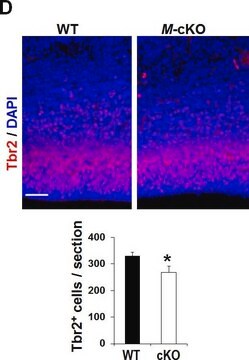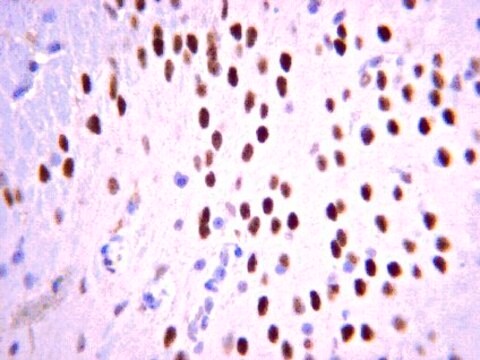AB15894
Anti-Tbr2 Antibody
from chicken, purified by affinity chromatography
Synonym(s):
Eomesodermin homolog, T-box brain protein 2, T-brain-2, TBR-2, Tbr2
About This Item
Recommended Products
biological source
chicken
Quality Level
antibody form
affinity isolated antibody
antibody product type
primary antibodies
clone
polyclonal
purified by
affinity chromatography
species reactivity
mouse
species reactivity (predicted by homology)
human, rat
technique(s)
immunohistochemistry: suitable
western blot: suitable
isotype
IgY
NCBI accession no.
UniProt accession no.
shipped in
wet ice
target post-translational modification
unmodified
Gene Information
human ... EOMES(8320)
Related Categories
General description
Specificity
Immunogen
Application
Neuroscience
Developmental Neuroscience
- Immunohistochemistry (Paraffin) Analysis: A 1:1,000 dilution from a representative lot detected Tbr2 in Mouse brain tissue sections.
- Note: Actual optimal working dilutions must be determined by end user as specimens, and experimental conditions may vary with the end user.
Quality
Western Blotting Analysis: A 1:1,000 dilution of this antibody detected Tbr2 in E13-E14 Mouse brain tissue lysate.
Target description
Physical form
Storage and Stability
Analysis Note
E13-14 mouse brain lysate
Other Notes
Disclaimer
Not finding the right product?
Try our Product Selector Tool.
Storage Class Code
12 - Non Combustible Liquids
WGK
WGK 1
Flash Point(F)
Not applicable
Flash Point(C)
Not applicable
Certificates of Analysis (COA)
Search for Certificates of Analysis (COA) by entering the products Lot/Batch Number. Lot and Batch Numbers can be found on a product’s label following the words ‘Lot’ or ‘Batch’.
Already Own This Product?
Find documentation for the products that you have recently purchased in the Document Library.
Our team of scientists has experience in all areas of research including Life Science, Material Science, Chemical Synthesis, Chromatography, Analytical and many others.
Contact Technical Service







